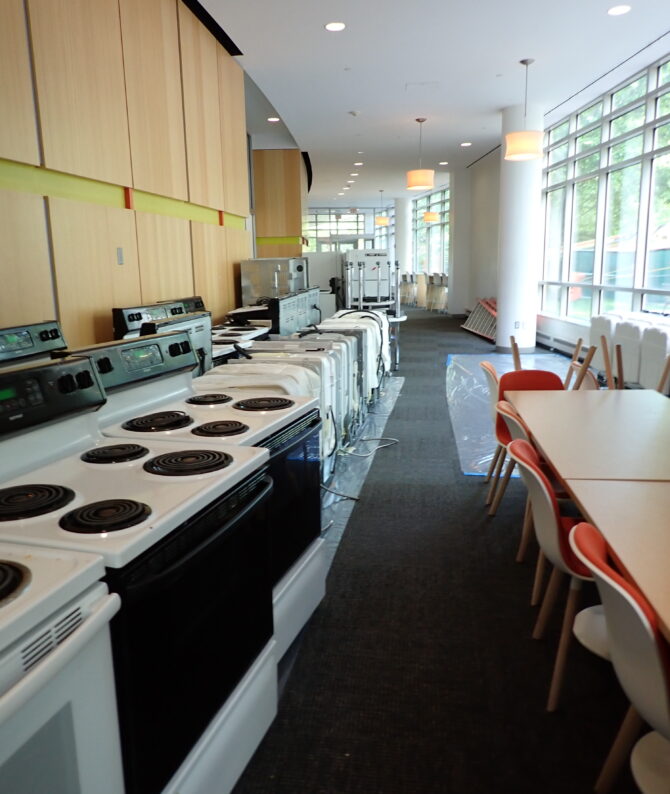What are RECs?

In most cases, there is no such thing as buying renewable electricity. Yes, we have wind turbines and solar panels, but the journey from renewable energy generation sites to where that energy is used takes place on the grid. When electricity is produced, it is fed into the grid no matter whether it comes from a wind farm or a coal plant. Because of the existing infrastructure of the grid, there is no separating out renewable electricity from electricity generated by burning fossil fuels; when it hits the grid, it’s all the same.
Electricity is often measured in kilowatts, or 1,000 watts. Kilowatts are a measure of how much power an appliance consumes. When customers are charged for electricity, they are charged for kilowatt hours (kWh), which is just how much power an appliance consumes in kilowatts per hour. For example, if you use your 1 kW toaster for 2 hours, that’s 2 kWh.
Northeastern University buys renewable energy certificates, known as RECs, to cover 100% of its electricity usage. That means for every mWh the school uses, one REC is purchased. The contracts usually span multiple years and the price of the RECs depend on where they came from.
RECs were designed to bridge the gap between renewable energy generators and customers who want to buy green power. They are a tag that is created for every megawatt hour (1,000 kWh) of renewable electricity generated. So, when a wind farm generates 1 mWh of electricity, they now have one REC. RECs are separate from the electricity and have their own market where people and companies can buy and sell them. They are a way to invest in renewable energy generators and an incentive for those generators to expand.
The amount of extra renewable energy that a customer’s purchase of RECs enables is referred to as additionality, but additionality doesn’t have to occur for RECs to be created or sold. This is why it’s best to think of RECs as a way to invest in the renewable energy market instead of as a way to prove you’re using renewable energy.
Although some like to claim that, because they used a certain number of mWh of electricity and purchased an equivalent number of RECs, they are “carbon neutral” or use “100% renewable energy,” the power they use isn’t any different than anyone else’s. The RECs they purchased simply means they invested in the renewable energy market in an effort to increase demand, hoping that renewables will become a greater percentage of the grid.
It’s important to recognize that a REC is not an offset. An offset is a certificate that represents one metric ton of carbon dioxide emissions being avoided. Although RECs and offsets work toward the same goal, RECs only represent renewable energy generation.
There is also the question of where RECs come from. Many less regulated areas of the United States have much cheaper RECs than in more regulated places because there is less demand. These are also usually the places with dirtier grids – ones where a smaller percentage of electricity comes from renewable sources. Private companies and citizens can purchase RECs from anywhere, regardless of where their electricity came from. This isn’t necessarily a bad thing, because making an investment in an area with a dirtier grid can help displace dirtier power sources like coal.
When there is a huge supply of RECs and prices are very low, they don’t provide a huge financial incentive for renewable energy generators to increase production; this is an instance when RECs might not provide much additionality. But, in the last year, REC prices have skyrocketed. Higher prices can mean a greater percentage of a renewable generator’s revenue coming from RECs, which makes them more important. The more money RECs bring in, the more they can directly provide additionality. This is why it’s so important for people to know about RECs and how they work; company A can buy 100 cheap RECs that aren’t doing much and company B can buy 100 expensive RECs that are providing tangible additionality, but they’ll probably both get the same accolades and PR boost.
Are RECs going to solve climate change? No. But they enable us to have a hand in supporting the renewable energy industry which is going to have to grow massively over the coming years if we have any chance of mitigating the issues that greenhouse gas emissions are creating.
Written by Adam Doucette – 3/9/2022



